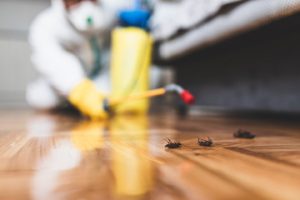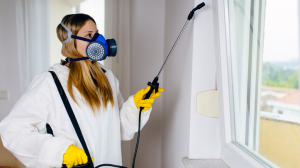If you have a problem with pests, you need to hire an exterminator to get rid of them. They have the knowledge and equipment to handle any infestation safely and effectively.
Their work involves detailed inspections of homes, businesses, and other structures to identify the types of pests and their sources. They also develop treatment plans and preventative strategies. Contact Exterminator Boise now!

Professionalism is a set of standards that one is expected to adhere to in the workplace. It often entails wearing a uniform, acting in an appropriate manner, and respecting co-workers and customers. However, what constitutes professionalism varies from workplace to workplace, and the definition can even vary between cultures.
When hiring a pest control expert, it’s important to consider their level of professionalism. Choosing a qualified, experienced exterminator is the best way to get rid of pests quickly and effectively. This means that they should have a portfolio of past clients to show you and the ability to create a customized plan for your specific needs.
Pests can be extremely damaging to homes and businesses. They can also cause health problems for family members and pets. Attempting to deal with infestations on your own can be costly and ineffective. It is best to contact a professional exterminator who uses eco-friendly pest control solutions to eliminate infestations safely and effectively.
A professional pest control expert is licensed, insured, and reputable. They will be able to provide proof of their license and qualifications upon request. This ensures that they will use safe, effective methods to eradicate pests and prevent future problems. A good pest control expert will have extensive knowledge of bugs and their life cycles, and they will be able to identify the type of bug you are dealing with and the best method to remove it.
Exterminators may work in a variety of environments, including residential homes, commercial buildings, and industrial facilities. They may also work in outdoor spaces, such as parks, gardens, and public lands. Some may specialize in managing pests in agricultural settings, such as orchards and vineyards.
Some exterminators focus on wildlife pests, such as raccoons, squirrels, and skunks. These exterminators use humane trapping and relocation techniques to remove pests from properties. They may also implement habitat modifications to prevent wildlife from entering buildings and causing damage. Other exterminators are able to offer prevention services, such as providing advice on sanitation practices and structural repairs that can reduce the risk of pest infestation.
Licensing
There are a number of licensing requirements that need to be met before an exterminator can become licensed in New York. These include passing the proper exams and training courses, meeting minimum experience levels, and having a satisfactory background check. Applicants must also pay the appropriate fees to get their license. Typically, a pesticide applicator license costs $75 and a pesticide dealer license costs $175. These fees are paid online through the Department of Environmental Conservation’s website.
Getting licensed is important for the pest control industry because it demonstrates a commitment to professionalism and quality work. It also protects consumers from unlicensed pest control companies that may be using illegal or unsafe chemicals and techniques. Licensing ensures that the pest control company has liability insurance in case of damage to property or bodily injury resulting from their work.
To become a licensed applicator, an individual must pass the core and appropriate category exams. In addition, they must submit verifiable experience letters and complete an approved pesticide applicator training course. Those seeking certification in the Commercial Applicator or Certified Technician categories must be no younger than 17 years of age and have one year of full-time verified experience as a pesticide applicator or as a pesticide technician. Those who wish to sell, use or supervise the sale of a restricted-use pesticide must be at least 21 years of age and have three years of verifiable experience in the sales category.
In some states, there are special licenses that are available for particular applications. For example, a wood-destroying organism (WDO) inspector license is specific to termites and carpenter ants and allows professionals to inspect structures for damage caused by these pests. Other specialty licenses, such as fumigation and seed treatment, require a minimum of 30 days of on-the-job training.
Licensed exterminators are more likely to provide high-quality services and are more knowledgeable about safety precautions than unlicensed exterminators. Additionally, they can be trusted to follow all applicable laws and regulations. The licenses that exterminators must obtain are an essential part of their job, as they allow them to legally apply and use pesticides.
Experience
An exterminator’s job is to rid homes, offices and other buildings of pests. They use a variety of techniques to do this, including using baits and traps, chemical sprays, heat treatments and fumigation. They also can seal up cracks and crevices to prevent pests from entering a building in the future.
The qualifications that an exterminator needs to have vary depending on the type of pests that they are working with. Some pests, such as termites, require a different treatment approach than other pests, such as mosquitoes. To be effective in their jobs, an exterminator should have a thorough understanding of the habits and life cycles of each pest that they are working with. This will allow them to create the most effective treatment plan for each situation.
Another important qualification that an exterminator should have is the ability to communicate effectively. This is because an exterminator will often need to explain their treatment plans to clients, which can be very technical and detailed. In addition, an exterminator should be able to answer any questions that the client may have about the treatment or the pests.
As an exterminator works, they will need to keep detailed records of the types of pests that they are dealing with, their treatment methods and the results that they have seen. This documentation is vital for long-term pest control and can also be necessary for regulatory compliance.
For this reason, an exterminator should have strong organizational skills in order to be able to manage their paperwork efficiently. In addition, they should have good physical stamina as this can be a physically demanding job. This is because an exterminator often needs to stand or crouch for hours at a time in difficult-to-reach spaces.
Finally, an exterminator should be able and willing to learn new skills as needed to advance in their careers. For example, if an exterminator wants to become a certified structural pest control operator, they will need to complete additional training and pass an exam. In addition, an exterminator should always stay up-to-date on the latest pest control technology and techniques.
Safety
An exterminator deals with the elimination of pests from homes, businesses, and industrial facilities. Pests can include insects like termites, cockroaches, and bed bugs, as well as rodents such as rats and mice. Pests can cause serious health issues if they are allowed to stay in your home or workplace. For example, mosquitoes spread diseases such as encephalitis, West Nile virus, Zika virus, dengue fever, and malaria, while fleas can spread the plague, typhus, and Rocky Mountain spotted fever. If you have a pest infestation, you should seek immediate help from a licensed and experienced exterminator.
Safety is a major concern for a professional exterminator. They must follow strict protocols when applying chemicals and using traps and bait stations. For instance, they must wear personal protective equipment when dealing with hazardous materials such as insecticides or rat poisons. They should also clean up contaminated areas after use and properly store their equipment.
Pest control professionals have an in-depth knowledge of the different types of pests and how they behave. They can use a wide range of methods to eliminate them, including insecticide sprays, bait traps, and even heat treatments or fumigation. They can also advise homeowners on how to prevent pests from entering their properties in the first place.
While exterminators can be a good choice for immediate pest problems, they do not always offer long-term solutions. This is because they rely on pesticides alone, which often results in the development of resistance by the pests. Furthermore, they rarely provide their services with a service satisfaction guarantee.
Moreover, an exterminator cannot address the underlying causes of the infestation. Hence, it is important to look for a pest management specialist instead. They can work with you to eradicate the current pests and implement methods that will sustain a zero-infestation status for the long term.
A pest control expert focuses on eliminating a problem without harming people, animals, or the environment. They also collaborate with customers to keep pests from returning. They do this by implementing preventive measures, such as ensuring there is no food available for the pests and sealing entry points into the property. They may also suggest landscaping tactics and cleaning strategies that can help to keep the pests away.


